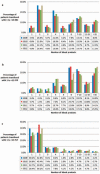Utilisation of blood components in cardiac surgery: a single-centre retrospective analysis with regard to diagnosis-related procedures
- PMID: 26019702
- PMCID: PMC4439773
- DOI: 10.1159/000377691
Utilisation of blood components in cardiac surgery: a single-centre retrospective analysis with regard to diagnosis-related procedures
Abstract
Background: More blood components are required in cardiac surgery than in most other medical disciplines. The overall blood demand may increase as a function of the total number of cardiothoracic and vascular surgical interventions and their level of complexity, and also when considering the demographic ageing. Awareness has grown with respect to adverse events, such as transfusion-related immunomodulation by allogeneic blood supply, which can contribute to morbidity and mortality. Therefore, programmes of patient blood management (PBM) have been implemented to avoid unnecessary blood transfusions and to standardise the indication of blood transfusions more strictly with aim to improve patients' overall outcomes.
Methods: A comprehensive retrospective analysis of the utilisation of blood components in the Department of Cardiac Surgery at the University Hospital of Münster (UKM) was performed over a 4-year period. Based on a medical reporting system of all medical disciplines, which was established as part of a PBM initiative, all transfused patients in cardiac surgery and their blood components were identified in a diagnosis- and medical procedure-related system, which allows the precise allocation of blood consumption to interventional procedures in cardiac surgery, such as coronary or valve surgery.
Results: This retrospective single centre study included all in-patients in cardiac surgery at the UKM from 2009 to 2012, corresponding to a total of 1,405-1,644 cases per year. A blood supply was provided for 55.6-61.9% of the cardiac surgery patients, whereas approximately 9% of all in-patients at the UKM required blood transfusions. Most of the blood units were applied during cardiac valve surgery and during coronary surgery. Further surgical activities with considerable use of blood components included thoracic surgery, aortic surgery, heart transplantations and the use of artificial hearts. Under the measures of PBM in 2012 a noticeable decrease in the number of transfused cases was observed compared to the period from 2009 to 2011 before implementation of the PBM initiative (red blood cells p < 0.002; fresh frozen plasma p < 0.0006; platelets p < 0.00006).
Conclusion: Until now, cardiac surgery comes along with a significant blood supply. By using a case-related data evaluation programme, the consumption of each blood component can be linked to clinical performance groups and, if necessary, to individual patients. Based on the results obtained from this retrospective analysis, prospective studies are underway to begin conducting target / actual performance comparisons to better understand the individual decision-making by the attending physicians with respect to transfusions.
Keywords: Blood supply; Blood transfusion; Cardiac surgery; Haemotherapy; Patient blood management.
Figures
References
-
- Anderson SA, Menis M, O'Connell K, Burwen DR. Blood use by inpatient elderly population in the United States. Transfusion. 2007;47:582–592. - PubMed
-
- Beguin C, Closon MC, Vandekerckhove P, Baele P. Concentration of transfusion resources on a few pathologies and a few patients: analysis of the comprehensive in-hospital patient database. Transfusion. 2007;47:217–227. - PubMed
-
- Gombotz H, Rehak PH, Shander A, Hofmann A. Blood use in elective surgery: the Austrian benchmark study. Transfusion. 2007;47:1468–1480. - PubMed
-
- Seifried E, Klüter H, Weidmann C, Staudenmaier T, Schrezenmeier H, Henschler R, Greinacher A, Müller MM. How much blood is needed? Vox Sang. 2011;100:10–21. - PubMed
-
- Brokent-Raven BA, Janssen MP, van der Poel CL, Schaasberg WP, Bonsel GJ, van Hout BA. The PROTON study: profiles of blood product transfusion recipients in the Netherlands. Vox Sang. 2010;99:54–64. - PubMed
LinkOut - more resources
Full Text Sources
Other Literature Sources



